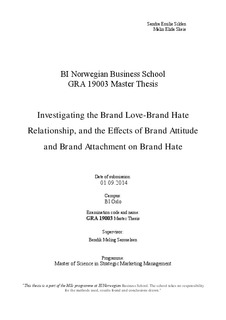| dc.description.abstract | There has been an increase in consumer research on consumer-brand relationships, specifically positive relationship between the consumer and brands. This thesis tries to shed light on a topic that has received less attention, though highly related, namely brand hate. Study 1 was conducted in order to investigate an antecedent to brand hate, building on the fact that love for a competing brand can cause brand hate. To our knowledge this topic has not been examined before. However, a line of research indicates that such relationships exists between brand hate and brand love. This relationship is very apparent in the sports industry, just imagine the rivalry between competing football teams. We believe that such relationships are mirrored in other categories as well, even though not as evident. Results from study 1 confirm this relationship in some of the investigated categories. Specifically, we get support for the hypothesis in product categories with high signaling value. Further, we get a surprising result showing that when hate (love) for one brand increases, so does hate (love) for the competing brand in that category. Study 2 was conducted to examine how consumers with love for a brand with high signaling value would react to positive information about a direct and an indirect competitor. Previous research indicates that when given positive information about a direct competitor, feelings of love, liking and attachment will increase, while positive information about an indirect competitor will have no effect on previous attitudes and attachment. Results from study 2 support our hypotheses to some degree. Positive information concerning the direct competitor showed significant results for brand attachment, but not for brand love and brand liking. Positive information concerning the indirect competitor showed no significant change across the three items, as expected. Findings from the current research contribute to literature by suggesting an antecedent of brand hate. Investigating further, results indicate that there are differences between categories with high badge value and those with lower badge value. In addition, our results confirm previous theory on the difference between brand attitudes and brand attachment. | nb_NO |
